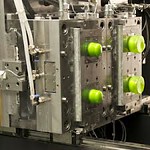Two-in-one process from Engel/Cantoni

AUSTRIAN machine maker Engel firmed up with Italian firm Cantoni to develop inject2blow that combines injection moulding and blow moulding in one mould on one injection moulding machine, thus reducing cycle time to 14 seconds for the manufacture of containers.
The manufacture of wide-necked jars is undertaken on a 90-tonne clamping force Engel victory injection moulding machine in a 2+2-cavity mould produced by Cantoni.
The companies say that traditional methods simply cannot match the production efficiency of inject2blow. Preforms normally have to be made using injection moulding first and then subjected to a second process on a blow moulding machine before they become a final product, but the new method allows small ready-to-use containers to be manufactured in one process. This combination method is the first of its kind available on the market.
Other benefits of integrating the processes include lower system investment costs, a smaller system footprint, higher system availability, simpler quality control, and no maximum clamping force. The inject2blow method can be used to process a wide range of thermoplastics from PE, PP and PCs to PET.
While Engel supplies the machine (either victory or e-victory series) and robot, Cantoni provides the sliding table mould. Both the injection moulding and blow moulding processes are visualised, monitored, and controlled via the Engel CC 200 control unit. This means that injection moulding machine operators don't have to learn how to use new technology; they will simply be guided intuitively through the integrated injection and blow moulding process by the control unit.
Despite the high degree of process integration and automation, manufacturing cells are flexible when they are in operation. Cavity inserts make it easier to change from one product to another, and the production of small batches economical. As the inject2blow process is based on standard injection moulding machines, the system can be used with moulds for classic injection moulding products too.
(PRA)
|